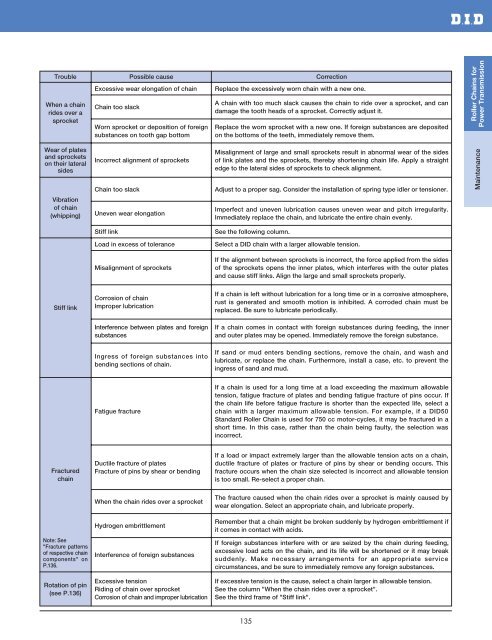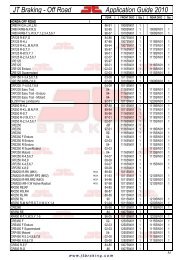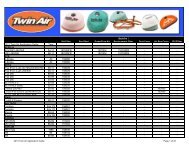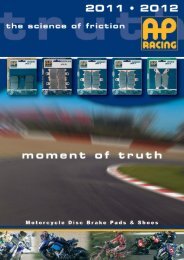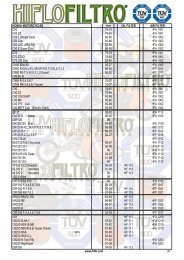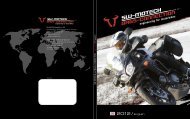DID 60 standard roller chain - Big Bike Webshop
DID 60 standard roller chain - Big Bike Webshop
DID 60 standard roller chain - Big Bike Webshop
You also want an ePaper? Increase the reach of your titles
YUMPU automatically turns print PDFs into web optimized ePapers that Google loves.
Trouble<br />
When a <strong>chain</strong><br />
rides over a<br />
sprocket<br />
Possible cause<br />
Excessive wear elongation of <strong>chain</strong><br />
Chain too slack<br />
Worn sprocket or deposition of foreign<br />
substances on tooth gap bottom<br />
Correction<br />
Replace the excessively worn <strong>chain</strong> with a new one.<br />
A <strong>chain</strong> with too much slack causes the <strong>chain</strong> to ride over a sprocket, and can<br />
damage the tooth heads of a sprocket. Correctly adjust it.<br />
Replace the worn sprocket with a new one. If foreign substances are deposited<br />
on the bottoms of the teeth, immediately remove them.<br />
Roller Chains for<br />
Power Transmission<br />
Wear of plates<br />
and sprockets<br />
on their lateral<br />
sides<br />
Vibration<br />
of <strong>chain</strong><br />
(whipping)<br />
Incorrect alignment of sprockets<br />
Chain too slack<br />
Uneven wear elongation<br />
Misalignment of large and small sprockets result in abnormal wear of the sides<br />
of link plates and the sprockets, thereby shortening <strong>chain</strong> life. Apply a straight<br />
edge to the lateral sides of sprockets to check alignment.<br />
Adjust to a proper sag. Consider the installation of spring type idler or tensioner.<br />
Imperfect and uneven lubrication causes uneven wear and pitch irregularity.<br />
Immediately replace the <strong>chain</strong>, and lubricate the entire <strong>chain</strong> evenly.<br />
Maintenance<br />
Stiff link<br />
See the following column.<br />
Load in excess of tolerance<br />
Select a <strong>DID</strong> <strong>chain</strong> with a larger allowable tension.<br />
Misalignment of sprockets<br />
If the alignment between sprockets is incorrect, the force applied from the sides<br />
of the sprockets opens the inner plates, which interferes with the outer plates<br />
and cause stiff links. Align the large and small sprockets properly.<br />
Stiff link<br />
Corrosion of <strong>chain</strong><br />
Improper lubrication<br />
If a <strong>chain</strong> is left without lubrication for a long time or in a corrosive atmosphere,<br />
rust is generated and smooth motion is inhibited. A corroded <strong>chain</strong> must be<br />
replaced. Be sure to lubricate periodically.<br />
Interference between plates and foreign<br />
substances<br />
If a <strong>chain</strong> comes in contact with foreign substances during feeding, the inner<br />
and outer plates may be opened. Immediately remove the foreign substance.<br />
Ingress of foreign substances into<br />
bending sections of <strong>chain</strong>.<br />
If sand or mud enters bending sections, remove the <strong>chain</strong>, and wash and<br />
lubricate, or replace the <strong>chain</strong>. Furthermore, install a case, etc. to prevent the<br />
ingress of sand and mud.<br />
Fatigue fracture<br />
If a <strong>chain</strong> is used for a long time at a load exceeding the maximum allowable<br />
tension, fatigue fracture of plates and bending fatigue fracture of pins occur. If<br />
the <strong>chain</strong> life before fatigue fracture is shorter than the expected life, select a<br />
<strong>chain</strong> with a larger maximum allowable tension. For example, if a <strong>DID</strong>50<br />
Standard Roller Chain is used for 750 cc motor-cycles, it may be fractured in a<br />
short time. In this case, rather than the <strong>chain</strong> being faulty, the selection was<br />
incorrect.<br />
Fractured<br />
<strong>chain</strong><br />
Ductile fracture of plates<br />
Fracture of pins by shear or bending<br />
If a load or impact extremely larger than the allowable tension acts on a <strong>chain</strong>,<br />
ductile fracture of plates or fracture of pins by shear or bending occurs. This<br />
fracture occurs when the <strong>chain</strong> size selected is incorrect and allowable tension<br />
is too small. Re-select a proper <strong>chain</strong>.<br />
When the <strong>chain</strong> rides over a sprocket<br />
The fracture caused when the <strong>chain</strong> rides over a sprocket is mainly caused by<br />
wear elongation. Select an appropriate <strong>chain</strong>, and lubricate properly.<br />
Hydrogen embrittlement<br />
Remember that a <strong>chain</strong> might be broken suddenly by hydrogen embrittlement if<br />
it comes in contact with acids.<br />
Note: See<br />
"Fracture patterns<br />
of respective <strong>chain</strong><br />
components" on<br />
P.136.<br />
Interference of foreign substances<br />
If foreign substances interfere with or are seized by the <strong>chain</strong> during feeding,<br />
excessive load acts on the <strong>chain</strong>, and its life will be shortened or it may break<br />
suddenly. Make necessary arrangements for an appropriate service<br />
circumstances, and be sure to immediately remove any foreign substances.<br />
Rotation of pin<br />
(see P.136)<br />
Excessive tension<br />
Riding of <strong>chain</strong> over sprocket<br />
Corrosion of <strong>chain</strong> and improper lubrication<br />
If excessive tension is the cause, select a <strong>chain</strong> larger in allowable tension.<br />
See the column "When the <strong>chain</strong> rides over a sprocket".<br />
See the third frame of "Stiff link".<br />
135


